12DOVE Verdict
Although it's not the best starting point for newcomers, veterans of the series will eat this up. Besides being great fun to play, Unmatched - Battle of Legends Vol. 2 is a striking lesson in how designers can get maximum variety from simple rules.
Pros
- +
Astonishing amount of strategy and tactics from simple rules
- +
Each character has a new and distinctive play style
- +
Great miniatures and card art at an attractive price point
Cons
- -
Not the best Unmatched set to start off with
- -
Has balance issues between the four included characters
Why you can trust 12DOVE
Unmatched - Battle of Legends Vol. 2 is the latest entry in a series that seeks to answer a question we've all asked at one point or another. You know the conversational game that’s played the world over, where you discuss which of two media or mythical figures would win in a fight? This franchise takes that and turns it into a fast-paced tactical skirmish game. It lets you face Medusa off against the Jurassic Park raptors, or Buffy against Bigfoot.
As the name suggests, this is the latest in a collection of board games that keep adding new characters to the mix. But does Unmatched - Battle of Legends Vol. 2 work as well as its predecessors? Yes... though it'll largely depend on your experience with the series.
What is it, and how does it work?
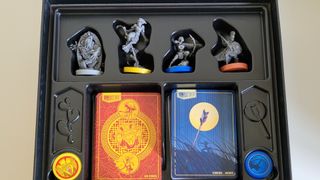
- Game type: Skirmish
- Players: 2 - 4
- Complexity: Moderate
- Lasts: 30 mins
- Ages: 14+
- Price: $39.99 / £41.99
- Play if you enjoy: Godtear, Warhammer Underworlds
Although the Unmatched series has been around for a few years now, this is a standalone box which also combines with existing releases from the franchise. Volume 2 really showcases how flexible the system is with four characters from different source materials. It lets you play with urban legend Bloody Mary, Greek hero Achilles, Chinese monkey trickster Sun Wukong, and legendary warrior princess Yennenga of Burkina Faso. The latter three also have sidekick pieces to control alongside their main hero.
Despite this flexibility, the core system of Unmatched - Battle of Legends Vol. 2 is strikingly simple. Each character has a dedicated deck of cards. On your turn, you take two actions which can be any combination of moving, attacking, or scheme. If you move, you draw a card and can then position your characters around the point-to-point map. Attacking means playing an attack card against an adjacent target for a melee strike, or one in the same board zone for a ranged blow (either way, the target gets to play a defence and take the difference between the two values in damage). Meanwhile, schemes are special cards that have a powerful one-off effect.
No matter what you do, the last figure standing wins.
It’s amazing how new releases manage to keep on delivering fresh takes on its simple premise
Although there are nearly 30 different characters available for Unmatched, it’s amazing how new releases manage to keep on delivering fresh takes on its simple premise. Achilles is probably the most straightforward. He starts out fighting alongside his friend, Patroclus. But you’re actually seeking to sacrifice Patroclus because doing so gives Achilles a huge attack power boost. His card deck includes various ways to put Patroclus in harms way, including suicide attacks and a defence card that swaps the two characters round with the new target taking the pain.
Yennenga commands two archer minions, on the other hand, and they’re all about ranged attacks and healing. Her archers can take damage in Yennenga’s place, but her cards help her reclaim health and can put dead archers back on the board, meaning she’s got a lot of staying power.
Bloody Mary is a huge contrast to this because she doesn’t have any sidekicks, but makes up for it with a huge special ability: if she has exactly 3 cards, she gets a third action. So her play style and her card effects are all about helping her cycle and control her hand size.
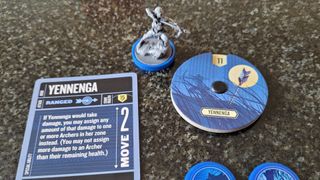
Most unusual of all is Sun Wukong. While he doesn’t begin with any minions on the board, he can create them, clones of himself, by sacrificing his health. But the kicker is that because they’re all clones, they’re all just as powerful as Sun Wukong, albeit with only a single point of health. But they can still play the same attack cards and kick out the same damage as the original, making them formidable, if fragile, opponents.
Just note that veterans of previous Unmatched sets will find there are a couple of new rules to digest. First are double attack cards, which trigger a second attack after the first one is resolved, a really nasty double-whammy. The second is split-level board spaces that give an attack bonus if you’re striking down the gradient.
Gameplay - is it any good?
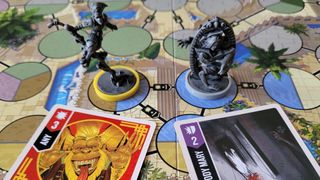
It’s astonishing how much Unmatched wrings out of its bare bones rules. While the board art is pretty ugly - especially in comparison to the superb card illustrations and dynamic miniatures - the actual layout is well designed to maximize maneuvers. There are loops and twists, making it easy to try and gain tactical advantage while making it hard to run away and hide. Heroes that have minions can use them to try and corner an opponent and restrict their moves. The high ground attack bonus just adds to the sense that you’re circling each other, looking for an opening to strike.
Timing, however, is always very tricky. With only two chances to act, an attack normally takes a single maneuver action followed by the attack play. And if the target survives, they get the chance to strike back twice. So it’s very tempting to try and stock up on defensive cards before you try. But the hand limit of seven cards is always working against you, especially given that there’s no reshuffle, so running the deck down is suicide.
Fighting and moving are an intricate, interesting dance
Yet because you only draw when you move, if you attack twice you risk leaving yourself low on cards. And a lot of attack cards are also dual-use attack/defense cards, so the more you dish the pain, the more you’re likely to be open to punishing retaliation. On top of that, combat has "during" and "after" effects where special powers on attack and defense cards can kick in and interact in unexpected ways. Bloody Mary’s deck, for example, contains 'Ghostly Touch' which allows her to boost her attack during combat and recover health after. Meanwhile, Sun Wukong’s 'Bewilderment' can potentially nullify it by preventing damage during combat and moving Sun Wukong after.
So fighting and moving are an intricate, interesting dance before you’ve even begun to add in the unique cards and special powers of the characters. Yennenga is perhaps the least interesting, with her combination of healing and archery feeling a bit like a mix of Alice and Medusa from the Unmatched Volume 1 set. But her new dual-use attack cards and the higher ground board spaces still help her feel fresher than she actually is.
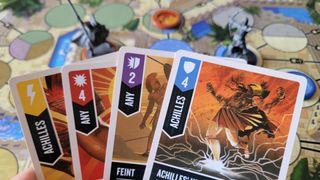
The other characters all bring something new and surprising to the table. Achilles can be a combat monster but the constant push-pull of wanting to both keep Patroclus alive for the extra options he offers and wanting him dead for the combat buff is fun to master. Bloody Mary is a fresh puzzle every turn as you try to work out plays that leave you with three cards for that super powerful bonus action. Sun Wunkong is probably best of all, with his infuriating but costly cloning ability helping him mess with both his player and their opponent in a way that befits trickster figures from mythology worldwide.
There is, however, a cost to all this variety. None of the Unmatched games can boast anything close to perfect balance between the characters, and this is no exception. Achilles is a bit too easy to play and a bit too powerful. Yennenga, by contrast, is slightly underpowered, especially against Bloody Mary. And it won’t be long before you start to feel you know the thirty cards in each character deck a little too well and yearn to start adding in some new matchups from expansions. There’s plenty to choose from, but it’s a slippery slope into the wider system that's becoming a mainstay in the realm of board games for adults.
Should you buy Unmatched - Battle of Legends Vol. 2?
As a whole, the Unmatched series carries a high recommendation. Not only is it great fun to play, especially in smaller doses, with the cut and thrust of tactical card play and maneuver contrasting well with the longer strategies of deck management. It’s also a striking lesson in how designers can wring the maximum variety from simple rules. If you’re new to the franchise, though, Unmatched - Battle of Legends Vol. 2 may not be the best starting point. The new rules make it slightly more complex than its predecessors and the Unmatched: Cobble & Fog set has better flavour and better balance. Veterans will eat this up, though, with its superb new characters and extra options.
How we tested Unmatched - Battle of Legends Vol. 2
I played Unmatched - Battle of Legends Vol. 2 numerous times with each of its different characters to get a feel for how they handle, particularly in relation to balance. I also compared them directly to previous entries based on my experience with the franchise to date, including how the experience ranks for beginners vs experienced fans.
Matt is a freelance writer specialising in board games and tabletop. With over a decade of reviews under his belt, he has racked up credits including IGN, Dicebreaker, T3, and The Guardian.
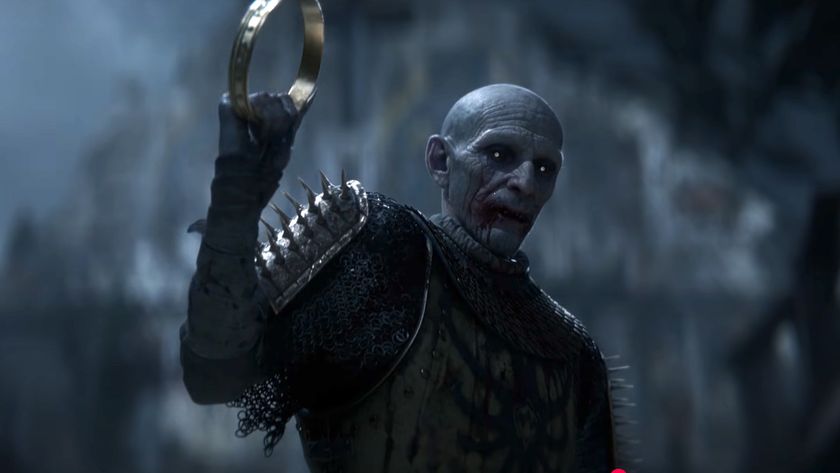
Blood of Dawnwalker devs explain how the vampire RPG's "narrative sandbox" builds on what they were "known for crafting" in games like The Witcher 3
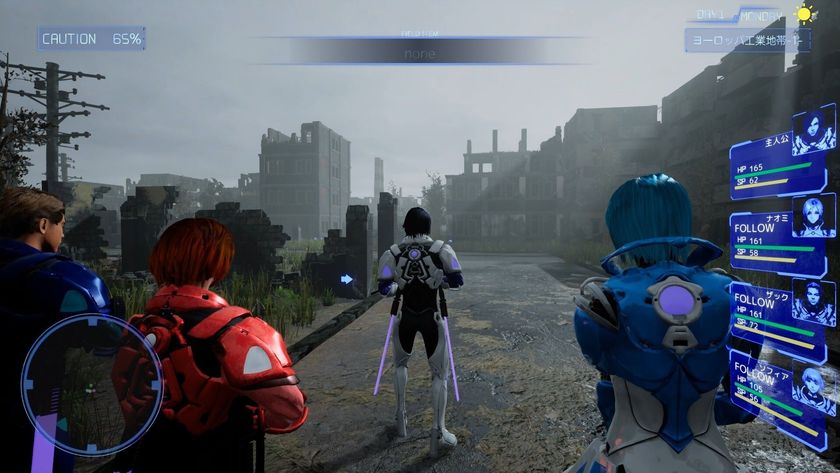
Persona and Metaphor: ReFantazio composer's new JRPG gets a Steam Next Fest demo, and it's basically a turn-based Metal Gear Solid
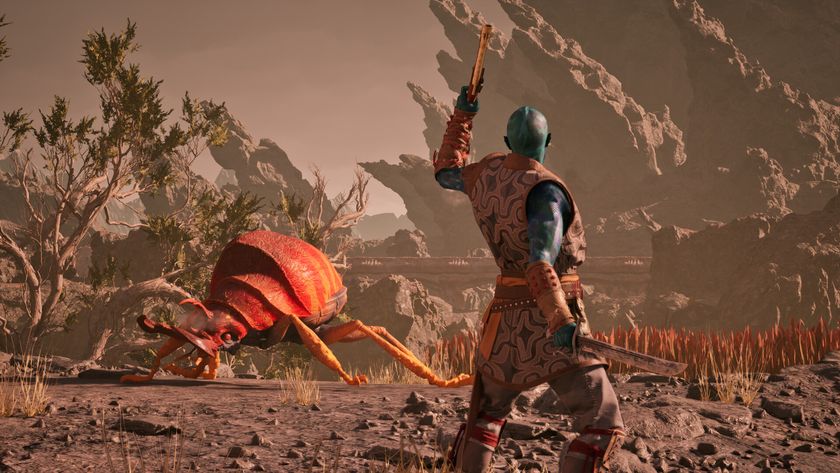
Avowed is nothing like Bethesda's RPGs, but The Elder Scrolls 6 should take inspiration from its combat
Most Popular





